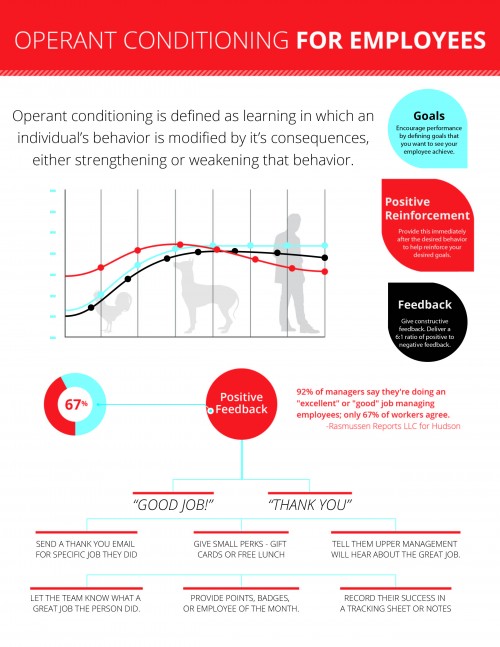Download the cheat sheet PDF for operant conditioning here.
An employee who started with a good attitude working at Coalition had his performance degrade over time. As his work performance became worse and worse, I came down on him harder and harder. I spent at least twenty minutes a day in special meetings with him trying to tell him what he was doing wrong and what he should be doing instead. All of my efforts were to no avail, eventually he just stopped showing up for work period. What happened in this situation?
The key to understanding employee behavior and work ethic is to start by understanding the fundamental laws of operant conditioning. Operant conditioning describes the processes by which any organism (ranging from a chicken to a dog to an employee in your organization to yourself) learns new behaviors.
Operant conditioning is defined as learning in which an individual’s behavior is modified by it’s consequences, either strengthening or weakening that behavior. For example if you touch your hand to a hot stove, suffering a burn that will provide a strong negative reinforcement.
How does operant conditioning change human (your employees) behavior?
- State the goal. What behavior do you specifically want to encourage? At Coalition we define goals in terms of KPIs (Key Performance Indicators). A KPI needs to be specific, measurable, and easily understood. Don’t assign more than 2-3 KPI’s per employee and make sure you let each employee know how important each KPI is to you.
- Monitor the behavior. Track KPIs in a way that is easily understood and accessible to the employee. Make sure it is logged.
- Provide positive reinforcement immediately following the person performing the desired behavior. It is extremely important to give employees positive reinforcement at least daily for their desired behavior. Desired behavior would be any work that helps them with their KPI. Managers are responsible for identifying this desired behavior and reinforcing it by smiling and telling the employee thank you and complimenting them for their good work.
- Provide feedback when the employee performs incorrect behaviors, but be cautious here. Make sure feedback is delivered in a constructive, correcting manner. Also be certain that you deliver at least a 6:1 ratio of positive feedback to negative feedback.
Positive Reinforcers for Employees
- SMILE at them 🙂
- Say “Thank you”
- Say “Nice work”, “Good job”, “Well done”, etc
- Tell them “I will let upper management know what a great job you did on X project”.
- Record what they did in a tracking sheet or their 1 on 1 meeting notes or even a chart on the wall with stars
- Email them personally and thank them specifically for what they did
- Email their team and let the team know waht the person accomplished
- Provide “points” or “badges” of some kind
- Give the employee a small thank you perk such as a starbucks card or a voucher for a movie ticket or by taking them to breakfast or lunch.
